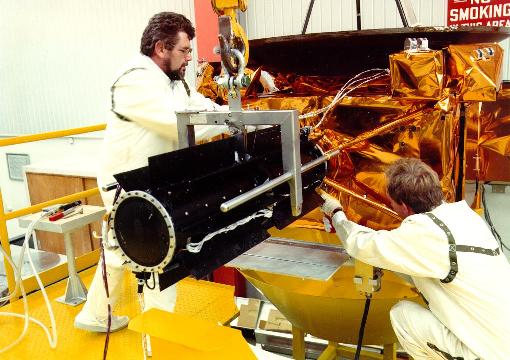RTG - Ulysses
Spacecraft Power for Ulysses
Electrical power sources like the one used on board Ulysses - Radioisotope Thermoelectric Generators (RTG) - have provided electrical power for some of the U.S. space program's greatest successes, including the Apollo lunar landings and the Viking Landers that searched for life on Mars. RTGs made possible the celebrated Voyager explorations of Jupiter, Saturn, Uranus and Neptune, as well as the Pioneer missions to Jupiter and Saturn. RTGs are powering the Galileo mission at Jupiter and will be used for the Cassini/Huygens

The RTG and Ulysses undergo a fit-check.
What Are RTGs?
RTGs are lightweight, compact spacecraft power systems that are highly reliable. RTGs are NOT nuclear reactors and have no moving parts. They use neither fission nor fusion processes to produce energy. Instead, they provide power through the natural radioactive decay of plutonium (mostly Pu-238, a non-weaponsgrade isotope). The heat generated by this natural process is changed into electricity by solid-state thermoelectric converters. RTGs enable spacecraft to operate at significant distances from the Sun or in other areas where solar power systems would not be feasible. In this context, they remain unmatched for power output, reliability and durability.
Safety Design
More than 30 years have been invested in the engineering, safety analysis and testing of RTGs. Safety features are incorporated into the RTG's design, and extensive testing has demonstrated that they can withstand physical conditions more severe than those expected from most accidents.
First, the fuel is in the heat-resistant, ceramic form of plutonium dioxide, which reduces its chance of vaporizing in fire or reentry environments. This ceramic-form fuel is also highly insoluble, has a low chemical reactivity, and primarily fractures into large, non-respirable particles and chunks. These characteristics help to mitigate the potential health effects from accidents involving the release of this fuel.
Second, the fuel is divided among 18 small, independent modular units, each with its own heat shield and impact shell. This design reduces the chances of fuel release in an accident because all modules would not be equally impacted in an accident.
Third, multiple layers of protective materials, including iridium capsules and high-strength graphite blocks, are used to protect the fuel and prevent its accidental release. Iridium is a metal that has a very high melting point and is strong, corrosion resistant and chemically compatible with plutonium dioxide. These characteristics make iridium useful for protecting and containing each fuel pellet. Graphite is used because it is lightweight and highly heat-resistant.
- Removed a total of (1) align=center.








































 Sign in
Sign in
 Science & Technology
Science & Technology